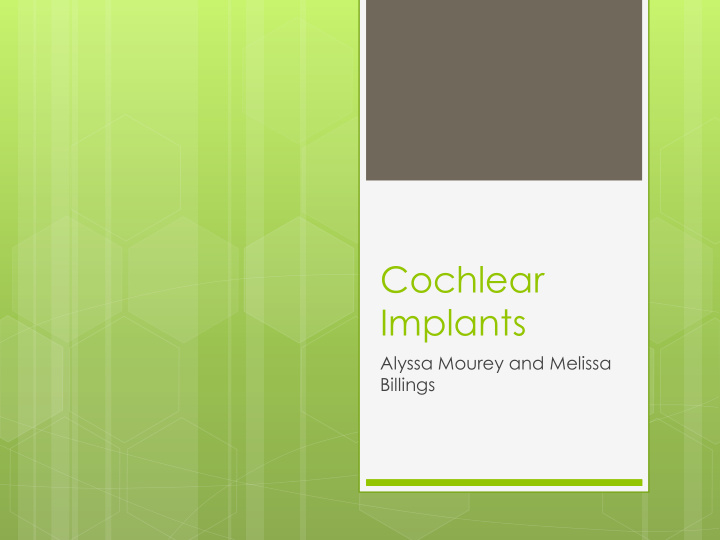



Cochlear Implants Alyssa Mourey and Melissa Billings
Hearing Loss Defined by type and severity Conductive Sensorineural Mixed Degree of Loss
Basic Information 36 million have hearing loss 7 years is the amount of time hearing loss is denied 20% of those who benefit from hearing aids wear them
Rehabilitation Options Hearing Aids
Rehabilitation Options Cochlear Implants
History Began in late 1800s with discovery of electrolytic cell by Alessandro Volta Stimulation with a direct current could not reproduce a quality sound Electrical stimulus with negative polarity worked best and correct electrode placement reduced unpleasant side effects
More Recent History Determined the cochlea was the site of stimulation 3 mechanisms that produced hearing Middle ear Basilar membrane Auditory nerve
Internal Parts Receiver Electrode Array
External Parts Speech Processor Microphone Transmitter
How it Works Provides direct electrical stimulation to the auditory nerve in inner ear ( 4ms ) Damage to hair cells in cochlea prevent sounds from reaching auditory nerve Damaged hair cells are bypassed Does not cure or restore hearing Destroys any hearing one may have Allows for perception of the sensation of sound Music
Who Qualifies? Anyone who is deaf or severely hard-of- hearing 219,000 people worldwide 42,600 adults in the USA 28,400 children in the USA Adults Children Barriers
Controversy Age Deaf culture Decline of sign language Lack of special education Needs not recognized Surgery itself Development of biological treatment
Simulations 24 channel http://ent.uci.edu/sounds/norm%20speech _M0_C500_N24.wav http://ent.uci.edu/sounds/norm%20speech. wav Music http://www.healthaffairs.uci.edu/hesp/proc Sim/Music_Original.wav http://www.healthaffairs.uci.edu/hesp/proc Sim/music_simu.wav
Recommend
More recommend